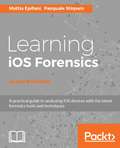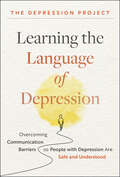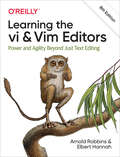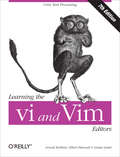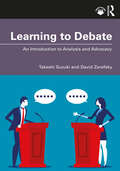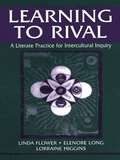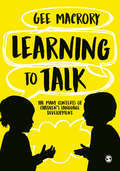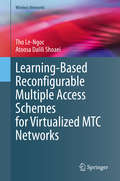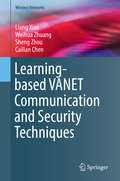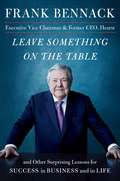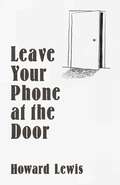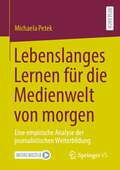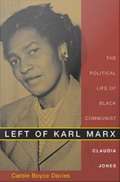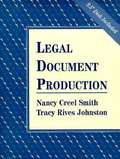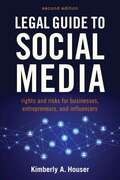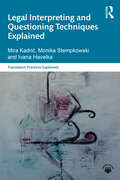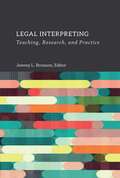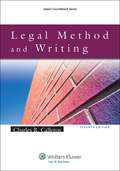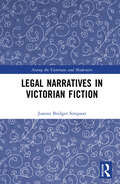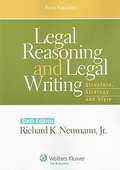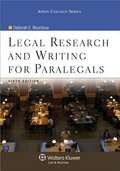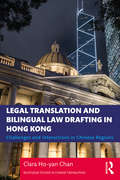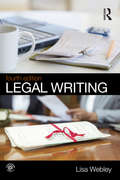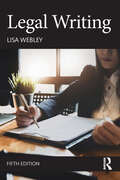- Table View
- List View
Learning iOS Forensics - Second Edition
by Pasquale Stirparo Mattia EpifaniA practical guide to analyzing iOS devices with the latest forensics tools and techniques About This Book * This book is a comprehensive update to Learning iOS Forensics * This practical book will not only cover the critical aspects of digital forensics, but also mobile forensics * Whether you're a forensic analyst or an iOS developer, there's something in this book for you * The authors, Mattia Epifani and Pasquale Stirparo, are respected members of the community, they go into extensive detail to cover critical topics Who This Book Is For The book is for digital forensics analysts, incident response analysts, IT security experts, and malware analysts. It would be beneficial if you have basic knowledge of forensics What You Will Learn * Identify an iOS device between various models (iPhone, iPad, iPod Touch) and verify the iOS version installed * Crack or bypass the protection passcode chosen by the user * Acquire, at the most detailed level, the content of an iOS Device (physical, advanced logical, or logical) * Recover information from a local backup and eventually crack the backup password * Download back-up information stored on iCloud * Analyze system, user, and third-party information from a device, a backup, or iCloud * Examine malicious apps to identify data and credential thefts In Detail Mobile forensics is used within many different domains, but is chiefly employed in the field of information security. By understanding common attack vectors and vulnerability points, security professionals can develop measures and examine system architectures to harden security on iOS devices. This book is a complete manual on the identification, acquisition, and analysis of iOS devices, updated to iOS 8 and 9. You will learn by doing, with various case studies. The book covers different devices, operating system, and apps. There is a completely renewed section on third-party apps with a detailed analysis of the most interesting artifacts. By investigating compromised devices, you can work out the identity of the attacker, as well as what was taken, when, why, where, and how the attack was conducted. Also you will learn in detail about data security and application security that can assist forensics investigators and application developers. It will take hands-on approach to solve complex problems of digital forensics as well as mobile forensics. Style and approach This book provides a step-by-step approach that will guide you through one topic at a time. This intuitive guide focuses on one key topic at a time. Building upon the acquired knowledge in each chapter, we will connect the fundamental theory and practical tips by illustrative visualizations and hands-on code examples.
Learning the Language of Depression: Overcoming Communication Barriers so People with Depression Are Safe and Understood
by The Depression ProjectIn order for people with depression to feel safe and understood, it's essential to overcome depression's "language barrier" As The Depression Project hears every single day from members of their 3,000,000+ person social media community, a “language barrier” often exists between people with depression and those around them — in the sense that many words, everyday expressions and non-verbal forms of communication can take on a vastly different meaning than they otherwise would when they are coming from someone who has depression. And, as The Depression Project also continuously hears, this “language barrier” can result in people with depression being judged and criticized; having conflict with their loved ones; feeling alone, misunderstood and unsupported; and being more at risk of attempting suicide. Consequently, in order to overcome this “language barrier” and therefore help people with depression feel safe, understood, supported and much better as a result. This book will: Explain what people with depression are actually going through when they say “I have depression” (it is much more than sadness); when they say “I'm fine” (very often they are not); when they say “I'm tired” (“depression tiredness” is very different from “normal tiredness”); when they say “I can't” (which is often misinterpreted as “I won't”, and as that person with depression just being “lazy”); and when they say other commonly spoken phrases that are often misunderstood by people who have never experienced depression themselves before. Share a wide variety of suggestions to help make it easier for people with depression to put what they are going through into words. Highlight the language people with depression often use that can indicate they are feeling suicidal (which tragically, is often ignored, dismissed or not picked up on by the people around them). Look at depression's “facial language barrier”, and explain what people with depression are often actually going through when they smile, avoid eye contact, have muted facial expressions, or look tired or frustrated (when a person has depression, these facial expressions and interactions can often mean something very, very different than they otherwise would). Address depression's “touch language barrier” by clarifying the reasons why depression can cause someone to be much less tactile and physically intimate than they would otherwise be, and by explaining the steps that can be taken to help prevent this lack of physical intimacy from spiraling into long-term relationship problems. Learning The Language Of Depression is an ideal book for people with depression who would like some help communicating what they are going through so that they can be better understood, as well as friends and family of someone with depression who would like to better understand their loved one and effectively support them.
Learning the vi and Vim Editors: Power and Agility Beyond Just Text Editing
by Arnold Robbins Elbert HannahAmong the text editors being used in the programming community, perhaps the most important family is vi and its derivatives. With this updated edition, Unix and Linux users will learn text editing basics for both vi and Vim ("vi improved") before moving on to advanced editing tools for each editor. Authors Arnold Robbins and Elbert Hannah cover the latest major releases of Vim, including 8.0 and 8.2.If you're a programmer or computer analyst, or you work with browsers or command-line interfaces, using Vim can speed up your work and make complex tasks easier. You'll examine multiwindow editing, global search and replacement, and power tools for programmers, and learn how to write interactive macros and scripts to extend the editor--all in the easy-to-follow style that's made this book a classic.Go beyond the basics to learn which vi commands fit your specific needsLearn advanced vi tools that shift most of the editing burden to the computerExplore Vim tools that provide major improvements over viExamine Vimâ??s multiwindow editing feature, a significant upgrade over viUse Vim scripts to customize and tailor Vim to your needsLook at Vim in modern GUI environments with Graphical Vim (gvim)See Vim in the broader programming milieu, including usingit as an IDE
Learning the vi and Vim Editors: Text Processing at Maximum Speed and Power
by Linda Lamb Arnold Robbins Elbert HannahThere's nothing that hard-core Unix and Linux users are more fanatical about than their text editor. Editors are the subject of adoration and worship, or of scorn and ridicule, depending upon whether the topic of discussion is your editor or someone else's. vi has been the standard editor for close to 30 years. Popular on Unix and Linux, it has a growing following on Windows systems, too. Most experienced system administrators cite vi as their tool of choice. And since 1986, this book has been the guide for vi. However, Unix systems are not what they were 30 years ago, and neither is this book. While retaining all the valuable features of previous editions, the 7th edition of Learning the vi and vim Editors has been expanded to include detailed information on vim, the leading vi clone. vim is the default version of vi on most Linux systems and on Mac OS X, and is available for many other operating systems too. With this guide, you learn text editing basics and advanced tools for both editors, such as multi-window editing, how to write both interactive macros and scripts to extend the editor, and power tools for programmers -- all in the easy-to-follow style that has made this book a classic.Learning the vi and vim Editors includes:A complete introduction to text editing with vi: How to move around vi in a hurry Beyond the basics, such as using buffers vi's global search and replacement Advanced editing, including customizing vi and executing Unix commandsHow to make full use of vim: Extended text objects and more powerful regular expressions Multi-window editing and powerful vim scripts How to make full use of the GUI version of vim, called gvim vim's enhancements for programmers, such as syntax highlighting, folding and extended tags Coverage of three other popular vi clones -- nvi, elvis, and vile -- is also included. You'll find several valuable appendixes, including an alphabetical quick reference to both vi and ex mode commands for regular vi and for vim, plus an updated appendix on vi and the Internet. Learning either vi or vim is required knowledge if you use Linux or Unix, and in either case, reading this book is essential. After reading this book, the choice of editor will be obvious for you too.
Learning to Debate: An Introduction to Analysis and Advocacy
by David Zarefsky Takeshi SuzukiWritten in an accessible style, this textbook introduces undergraduate students to the theoretical and practical aspects of debate and outlines the fundamental skills of analysis and advocacy.Debate teaches students how to solve the problems that we face in everyday and public situations. This book allows readers to face such problems head on by equipping them with the knowledge and skills to analyze a situation, propose solutions, and present debates and arguments in a persuasive manner. Organized into two parts, the book begins by laying the theoretical foundations and offering a step-by-step guide to debate. Students are shown how to compare pros and cons, test evidence and reasoning, and defend and develop their own positions. Each chapter in part two explores key sample constructive, rebuttal, and summary debate speeches and includes exercises and assignments to allow students to actively engage with the material and experience debate in the classroom.Providing students with the tools to become responsible members of a democratic society, Learning to Debate: An Introduction to Analysis and Advocacy is an ideal textbook for undergraduate Argumentation and Debate and Speech Communication courses.Material for instructors, including PowerPoint slides and an instructor’s manual, is available at https://routledge.com/9781032671390.
Learning to Rival: A Literate Practice for Intercultural Inquiry (Rhetoric, Knowledge, and Society Series)
by Linda Flower Elenore Long Lorraine HigginsLearning to Rival tells the inside story of college and high school writers learning to "rival"--to actively seek rival hypotheses and negotiate alternative perspectives on charged questions. It shows how this interdisciplinary literate practice alters with the context of use and how, in learning to rival in school and out, students must often negotiate conflicts not apparent to instructors. This study of the rival hypothesis stance--a powerful literate practice claimed by both humanities and science--initially posed two questions: * how does the rival hypothesis stance define itself as a literate practice as we move across the boundaries of disciplines and genres, of school and community? * how do learners crossing these boundaries interpret and use the family of literate practices, especially in situations that pose problems of intercultural understanding? Over the course of this project with urban teenagers and minority college students, the rival hypothesis stance emerged as a generative and powerful tool for intercultural inquiry, posing in turn a new question: how can the practice of rivaling support the difficult and essential art of intercultural interpretation in education? The authors present the story of a literate practice that moves across communities, as well as the stories of students who are learning to rival across the curriculum. Learning to Rival offers an active, strategic approach to multiculturalism, addressing how people negotiate and use difference to solve problems. In the spirit of John Dewey's experimental way of knowing, it presents a multifaceted approach to literacy research, combining contemporary research methods to show the complexity of rivaling as a literate practice and the way it is understood and used by a variety of writers. As a resource for scholars, teachers, and administrators in writing across the curriculum studies, writing program administration, service learning, and community based projects, as well as literacy, rhetoric, and composition, this volume reveals how learning a new literate practice can force students to encounter and negotiate conflicts. It also provides a model of an intercultural inquiry that uses difference to understand a shared problem.
Learning to Talk: The many contexts of children’s language development
by Gee MacroryThere is a pressing need for new teachers to understand the wider context of language development and to know how best to support children in learning to talk. This accessible text introduces you to the numerous contexts of language development. It helps you understand the many ways in which children acquire language skills. Importantly, it provides a breadth of learning about language not offered by other texts exploring typical language development, atypical language development and learning more than one language. The book also explores the current literature and research on language development for primary aged children, supporting trainee teachers with their academic study.
Learning to Talk: The many contexts of children’s language development
by Gee MacroryThere is a pressing need for new teachers to understand the wider context of language development and to know how best to support children in learning to talk. This accessible text introduces you to the numerous contexts of language development. It helps you understand the many ways in which children acquire language skills. Importantly, it provides a breadth of learning about language not offered by other texts exploring typical language development, atypical language development and learning more than one language. The book also explores the current literature and research on language development for primary aged children, supporting trainee teachers with their academic study.
Learning-Based Reconfigurable Multiple Access Schemes for Virtualized MTC Networks (Wireless Networks)
by Tho Le-Ngoc Atoosa Dalili ShoaeiThis book assists readers with understanding the key aspects, problems and solutions related to the design of proper Multiple Access Schemes for MTC (Machine-Type Communications) and IoT applications in 5G-and-beyond wireless networks. An overview of MTC applications and their traffic features are also provided. In addition, it presents a comprehensive review of MTC access schemes including orthogonal multiple access schemes (OMA), non-orthogonal multiple access schemes (NOMA), massive MIMO-based schemes and fast uplink grant approaches. It also proposes efficient and reconfigurable access schemes deploying machine learning and optimization techniques to address the main requirements of MTC networks. This book discusses potential research directions to further enhance the performance of MTC access schemes.Machine-type communications are expected to account for the dominant share of the traffic in future wireless networks. While in traditional wireless networks, designed for human-type communications, the focus is on support of large packet sizes in downlink, machine-type communication systems deal with heavy uplink traffic. This is due to the nature of the tasks performed by machine-type communication devices, which is mainly reporting measured data or a detected event. Furthermore, in these networks, using the virtualization framework, the network infrastructure can be shared between different applications for which providing isolation is of high importance. To support these unique characteristics of machine-type communications, proper access schemes need to be developed, which is the focus of this book.This book benefits advanced-level students studying computer science and electrical engineering as a secondary textbook and researchers working in this field. Engineers and practitioners interested in the challenges and practical solutions of integrating MTC in the cloud radio access network of 5G-and-beyond cellular systems will want to purchase this book as well.
Learning-based VANET Communication and Security Techniques (Wireless Networks)
by Weihua Zhuang Liang Xiao Sheng Zhou Cailian ChenThis timely book provides broad coverage of vehicular ad-hoc network (VANET) issues, such as security, and network selection. Machine learning based methods are applied to solve these issues. This book also includes four rigorously refereed chapters from prominent international researchers working in this subject area. The material serves as a useful reference for researchers, graduate students, and practitioners seeking solutions to VANET communication and security related issues. This book will also help readers understand how to use machine learning to address the security and communication challenges in VANETs. Vehicular ad-hoc networks (VANETs) support vehicle-to-vehicle communications and vehicle-to-infrastructure communications to improve the transmission security, help build unmanned-driving, and support booming applications of onboard units (OBUs). The high mobility of OBUs and the large-scale dynamic network with fixed roadside units (RSUs) make the VANET vulnerable to jamming. The anti-jamming communication of VANETs can be significantly improved by using unmanned aerial vehicles (UAVs) to relay the OBU message. UAVs help relay the OBU message to improve the signal-to-interference-plus-noise-ratio of the OBU signals, and thus reduce the bit-error-rate of the OBU message, especially if the serving RSUs are blocked by jammers and/or interference, which is also demonstrated in this book.This book serves as a useful reference for researchers, graduate students, and practitioners seeking solutions to VANET communication and security related issues.
Leave Something on the Table: and Other Surprising Lessons for Success in Business and in Life
by Frank BennackOne of the most innovative minds in business provides an equally original guide to getting ahead.Frank Bennack’s accomplishments in media and business are unrivaled. He was named chief executive of Hearst in 1979, and for nearly 30 years he helped solidify the company’s reputation as a leader in consumer media, overseeing the purchase of more than two dozen television stations and several major newspapers (Houston Chronicle), the launch of top-selling magazines (O, The Oprah Magazine), and a partnership with ABC, now the Walt Disney Company, to create the pioneering cable networks A&E, HISTORY, and Lifetime. One of his greatest achievements was when, in 1990, he negotiated a 20 percent stake in ESPN for $167 million. The sports network would be valued by market analysts at roughly $30 billion. He also played a key role in Hearst’s march toward diversification, with acquisitions of business media assets including global ratings agency Fitch Group. In Leave Something on the Table, Bennack takes readers behind the scenes of these high-stakes moves and offers practical tips for excelling in the corporate world and beyond. He tells stories from his Texas childhood—a first job at 8, his own television show at 17—that foretold why he would become a CEO at 46. And he shares his encounters with US presidents, reflects on his longtime commitment to philanthropy, and describes his and his colleagues’ unwavering quest to build the visionary Hearst Tower. This is a heartfelt handbook for how to advance not only as a professional but as a person. As Bennack writes, “It’s not currently fashionable to make the case for the high road. It looks longer, and old-fashioned, and it’s easy to conclude that while you’re climbing the ladder, burdened by your values, others are reaching the top faster. But if the stories in these pages suggest a broader truth, it’s exactly the opposite: The high road is quicker, with a better view along the way, and more satisfaction at the summit.”
Leave Your Phone at the Door: The Joy of OFFLINE
by Howard LewisLeave Your Phone at the Door acts as a timely and topical reminder to look beyond our phones and enjoy the physical benefits of community, randomness and serendipity.Real life happens beyond your phone screen. Leave Your Phone at the Door embraces the OFFLINE philosophy, which is a celebration of the much underrated virtues of randomness and serendipity. Whether sharing stories of unexpected encounters, alarming behavioral trends or the joys of quiet and contemplation, Howard Lewis encourages us to adopt an open mind and a generosity of spirit whenever we are confronted by the unfamiliar or surprising or different. We all have an innate desire to communicate but our constant reliance today upon personal technology is stripping our sensibilities bare. But rather than focusing upon the limitations of social media and phones, Lewis is far more animated by the mindful reframing of our place in the world. He offers his insights on the importance of relating to people in person and advice on developing social skills and habits that enrich our lives. What began as an informal gathering with friends led to the launch of the OFFLINE dinner, which he has hosted for over fifteen years in London. Guests are drawn from all walks of life and invited to engage with one another without the distraction of their phones. OFFLINE is designed to be the antithesis of everything online but also recognizes that veering off road and then back on it is both valuable and necessary. It aims to challenge and provoke, question and answer, stimulate and amuse, nurture and nourish in a delightful and congenial setting. This book is an embodiment of that ethos. Leave Your Phone at the Door acts as a timely and topical reminder to look beyond our phones and enjoy the physical benefits of community, randomness and serendipity. Who knows where it may take you and whom you might meet?!
Lebenslanges Lernen für die Medienwelt von morgen: Eine empirische Analyse der journalistischen Weiterbildung
by Michaela PetekWarum „lebenslanges Lernen für die Medienwelt von morgen“ sowohl für Journalistinnen und Journalisten als auch für Medienunternehmen alternativlos ist, legt Michaela Petek hier in einer empirischen Analyse der journalistischen Weiterbildung dar. Im Vergleich zum seit fünf Jahrzehnten gut untersuchten Bereich der journalistischen Ausbildung wird damit erstmals in der Journalismusforschung die Weiterbildung umfassend unter die Lupe genommen. Michaela Peteks Ziel ist es, alle Akteure auf dem journalistischen Weiterbildungsmarkt in die Untersuchung mit einzubeziehen: Journalist*innen, Medienunternehmen und Weiterbildungsinstitutionen. Neben ökonomischen Zwängen sind es vor allem die technischen Innovationen, die den Wandel in der Medienlandschaft vorantreiben. So entstehen ständig neue Produkte und Formate, Redaktionsstrukturen, Arbeitsabläufe, Berufsbilder. In dieser sich rasant wandelnden Medienwelt ist die kontinuierliche Investition in Weiterbildung für Journalistinnen und Journalisten notwendig, um einem immer wieder neu an die Veränderungen anzupassenden journalistischen Kompetenzprofil gerecht zu werden.
Left of Karl Marx: The Political Life of Black Communist Claudia Jones
by Carole Boyce DaviesIn Left of Karl Marx, Carole Boyce Davies assesses the activism, writing, and legacy of Claudia Jones (1915-1964), a pioneering Afro-Caribbean radical intellectual, dedicated communist, and feminist. Jones is buried in London's Highgate Cemetery, to the left of Karl Marx--a location that Boyce Davies finds fitting given how Jones expanded Marxism-Leninism to incorporate gender and race in her political critique and activism. Claudia Cumberbatch Jones was born in Trinidad. In 1924, she moved to New York, where she lived for the next thirty years. She was active in the Communist Party from her early twenties onward. A talented writer and speaker, she traveled throughout the United States lecturing and organizing. In the early 1950s, she wrote a well-known column, "Half the World," for the Daily Worker. As the U. S. government intensified its efforts to prosecute communists, Jones was arrested several times. She served nearly a year in a U. S. prison before being deported and given asylum by Great Britain in 1955. There she founded The West Indian Gazette and Afro-Asian Caribbean News and the Caribbean Carnival, an annual London festival that continues today as the Notting Hill Carnival. Boyce Davies examines Jones's thought and journalism, her political and community organizing, and poetry that the activist wrote while she was imprisoned. Looking at the contents of the FBI file on Jones, Boyce Davies contrasts Jones's own narration of her life with the federal government's. Left of Karl Marx establishes Jones as a significant figure within Caribbean intellectual traditions, black U. S. feminism, and the history of communism.
Legal Document Production
by Nancy Creel Smith Tracy Rives JohnstonThis combination book/workbook/reference provides a well-rounded overview of the procedures to follow in producing legal documents in six areas of law, general legal correspondence, and miscellaneous documents. Readers gain hands-on experience formatting and producing documents using any software package, word processor, electronic typewriter, or standard typewriter. The book provides a realistic approach to the procedural process required in the court system; features a wide variety of hands-on projects that focus on the documents themselves-- i. e. , the projects are suitable for any word processing software used with a computer, electronic typewriter, word processor, or standard typewriter; includes projects that highlight the documents from a variety of states, including specific features of California, Florida, Illinois, New York, Ohio, Texas, Virginia.
Legal Guide to Social Media, Second Edition: Rights and Risks for Businesses, Entrepreneurs, and Influencers
by Kimberly A. HouserLearn how to navigate the ins and outs of the law and social media. How should you respond to a request to remove copyrighted materials from a Facebook page? If you create a Twitter username at work, who owns the username when you change jobs? Can you be sued for libel if someone thinks your posts are defamatory? If you&’ve ever asked yourself these kinds of questions, this pioneering legal handbook is for you. Despite the enormous growth in social media usage by businesses and influencers, very little has been written about the laws affecting their activities. In this new edition of the Legal Guide to Social Media, Kimberly A. Houser, law professor and tech attorney, explains the potential pitfalls and how to avoid them including what social media influencers could have done to protect themselves from the lawsuits resulting from the Fyre Festival debacle. Easy-to-understand, comprehensive, and up-to-date, the Legal Guide to Social Media, Second Edition provides the latest information on case law and statutes. It covers everything from privacy laws to the legal considerations in setting up a page or website as well as new governmental regulations. This plain English legal companion offers examples of and solutions to the kinds of situations you can expect to encounter when posting online content, whether for yourself, your own business, or on behalf of your client&’s business. You&’ll learn how to avoid liability for defamation and third-party posts, how to protect your own content, the unique legal issues surrounding social media in the workplace, and much, much more. The new edition covers new state regulations on privacy, data security and advertising; how to avoid intellectual property infringement actions; and the newer legal risks for influencers.
Legal Interpreting and Questioning Techniques Explained (Translation Practices Explained)
by Mira Kadrić Monika Stempkowski Ivana HavelkaLanguage and law are closely linked, and language is fundamental to the application of the law. Legal, criminalistic, translational and psychological aspects of communication come together in interpreted questioning (hearings, interrogations, interviews) and must be taken into account, especially since the way in which the questioning outcomes are evaluated can have far-reaching legal consequences. Building on empirical studies and practice, this accessible text provides a transdisciplinary examination of questioning methods and strategies. The institutional framework conditions of a questioning situation are examined in the context of transdisciplinary cooperation.This book also addresses the increasing use of technology and hybrid forms of translation and interpreting in the legal system, and shows different ways in which interpreters co-construct information. Chapters include summaries of key concepts and definitions, examples from existing literature combined with practical experience and the results of surveys conducted by the authors, as well as further reading and non-language-specific study activities. Activities include role plays on thematic scenarios involving different actors in criminal proceedings and discussion groups to enable reflection on ethical issues and discursive challenges.This is a vital text for both advanced students and professionals in interpreting studies and criminology.
Legal Interpreting: Teaching, Research, and Practice (The Interpreter Education Series #12)
by Jeremy L. BrunsonLinguistic minorities are often severely disadvantaged in legal events, with consequences that could impact one’s very liberty. Training for interpreters to provide full access in legal settings is paramount. In this volume, Jeremy L. Brunson has gathered deaf and hearing scholars and practitioners from both signed and spoken language interpreting communities in the United States, Canada, and the United Kingdom. Their contributions include research-driven, experience-driven, and theoretical discussions on how to teach and assess legal interpreting. The topics covered include teaming in a courtroom, introducing students to legal interpreting, being an expert witness, discourses used by deaf lawyers, designing assessment tools for legal settings, and working with deaf jurors. In addition, this volume interrogates the various ways power, privilege, and oppression appear in legal interpreting. Each chapter features discussion questions and prompts that interpreter educators can use in the classroom. While intended as a foundational text for use in courses, this body of work also provides insight into the current state of the legal interpreting field and will be a valuable resource for scholars, practitioners, and consumers.
Legal Method And Writing
by Charles CallerosHighly regarded and classroom-proven, the Legal Method and Writing takes a comprehensive approach to legal writing that bridges law school and law office. Exercises and real-life examples--many taken from actual cases--provide stepping-off points from which to practice legal thinking and communication. Calleros seamlessly weaves multicultural themes into many of the problems and examples to add context and enrich student understanding of legal issues.
Legal Narratives in Victorian Fiction (Among the Victorians and Modernists)
by Joanne Bridget SimpsonThe law holds up a mirror to society and reflects that society and its ongoing preoccupations. This book establishes legal interpretation as a mode of literary interpretation, contextualising the opinions and sociological background of literature within the context of the law of its period and examines the inherent role of the law in the construction of the narrative in the literature of the nineteenth century. From the approach to the operation of jurisprudence and legal application, to the prosecution of the poor, the criminological approach to moral panics and the use of the affirmative defence to mitigate women within society, this book explores the ways in which the authors of the period used the novel form as a way of challenging and critiquing the legal operating model of the world in which their characters found themselves; examining the way in which the authors of the period used the novel as a means of critiquing the nature of the role of the law within society, its impact upon the general public, and the reciprocity which exists between legal ideals and the society which manifests those ideals through thought and action. This is a useful text for students of nineteenth-century literature or the law.
Legal Reasoning and Legal Writing: Structure, Strategy, and Style (6th edition)
by Richard K. NeumannThe Sixth Edition of this respected and popular text remains grounded in the premise that legal reasoning and legal writing are best learned when they are taught together. Building on that foundation, Neumann continues to offer complete, clear, and timely coverage of how to form a legal argument and how to write an effective legal memorandum. Streamlined in its Sixth Edition, Legal Reasoning and Legal Writing features: comprehensive coverage of legal writing: the office memo; the motion memo; the appellate brief; eminently readable text, including an exceptionally lucid explanation of the reasoning behind the proof of a conclusion of law; a thoughtful treatment of all aspects of legal reasoning; student-friendly instruction on the process of writing, the mechanics of style, and grammar up-to-date examples and exercises; sample documents in the Appendices, including an office memo, motion memo, and two appellate briefs. Highly regarded author Richard K. Neumann, Jr. presents, in tandem, smart, in-depth coverage of legal writing and legal reasoning, supported by examples, writing samples, and extraordinarily clear and lucid exposition.
Legal Research and Writing For Paralegals (Sixth Edition)
by Deborah E. BouchouxFocusing on the issues that paralegals face on the job, Legal Research and Writing for Paralegals presents an organized and practical introduction to legal research and writing. The carefully updated Sixth Edition takes a close look at new products and developments in electronic research while continuing to build on the strength of its pedagogy. A comprehensive overview enriched by illustrations and exercises, this text features: * an approach that integrates writing strategies into research chapters to show the link between these two processes * thorough coverage of electronic research, with a chapter on Internet research and fee-based services, such as Lexis and Westlaw * pointers throughout for using electronic resources more effectively * helpful charts and diagrams that clearly illustrate complex topics * Practice Tips in each chapter that offer realistic and helpful suggestions for workplace success * State Your Answer exercises that help students learn how to navigate through cyberspace * Internet Assignmentswhich can be made state-specific;that give students practice finding information on-line * step-by-step guidance for proper citation formkeyed to the fourth edition of ALWD and the new 19th edition of The Bluebook * directions for how to update and validate legal authorities * samples of legal writing, such as letters, a court brief, and a legal memorandum Updated throughout, the new Sixth Edition gives you more: * expanded coverage of electronic research * how to use "Google Scholar" to locate cases * how to access government documents from GPO Access to FDsys * the new features from Westlaw and Lexis, including WestlawNext, the new "intuitive platform" the new Easy Search feature, and Case in Brief * Fastcase, the fee-based, computer-assisted system, its free "app" for iPhones, and other law-related apps * a new assignment that uses Loislaw * a new assignment that compares Shepardize and KeyCite * new sample pages
Legal Translation and Bilingual Law Drafting in Hong Kong: Challenges and Interactions in Chinese Regions (Routledge Studies in Chinese Translation)
by Clara Ho-yan ChanLegal Translation and Bilingual Law Drafting in Hong Kong presents a systematic account from a cross-disciplinary perspective of the activities of legal translation and bilingual law drafting in the bilingual international city of Hong Kong and its interaction with Mainland China and Taiwan in the use of legal terminology. The study mainly examines the challenges posed to English-Chinese translation in the past three decades by elaborate drafting and terminological equivalence, and offers educational and research solutions. Its primary goals are to create legal Chinese that naturally accommodates common law concepts and statutes from the English legal system and to reconcile Chinese legal terms from the different legal systems adopted by Hong Kong, Mainland China and Taiwan. The new directions in legal translation and bilingual law drafting in Hong Kong will have implications for other Chinese regions and for the world. The book is intended for scholars, researchers, teachers and students of legal translation and legal linguistics, legal translators, lawyers and legal practitioners who are engaged in translation, as well as all persons who are interested in legal language and legal translation.
Legal Writing
by Lisa WebleyLegal Writing guides students comprehensively through this vital legal skill and addresses a range of assessment methods from exam questions to final essays and problem answers. It considers how to deconstruct essay and problem questions and how to conduct and apply legal research to answer set questions. Lisa Webley explains how to reference others' work clearly and correctly, making this book a useful tool for students concerned about issues of plagiarism. It also focuses on how to develop critical thinking and communicate legal arguments, with both good and bad examples of written work considered and discussed in the text. Legal Writing is particularly useful for undergraduate students, especially at the beginning of degree studies, and for GDL and CPE students too. This fully revised fourth edition includes: Guidance on the avoidance of plagiarism including examples of poor practice and best practice. Worked examples throughout the text, including guidance on deciphering essay questions in exams and coursework, along with additional examples from across the legal curriculum on the companion website. An improved companion website with increased guidance for revision to allow students to test their progress and further engage with the topics in the book. Clearly written and easy to use, Legal Writing enables students to fully engage with essay and exam writing as a vital foundation to their undergraduate degree.
Legal Writing
by Lisa WebleyLegal Writing guides students comprehensively through this vital legal skill and addresses a range of assessment methods from exam questions to final essays and problem answers. It considers how to deconstruct essay and problem questions and how to conduct and apply legal research to answer set questions. Lisa Webley explains how to reference others’ work clearly and correctly, making this book a useful tool for students concerned about issues of plagiarism. Legal Writing also focuses on how to develop critical thinking and communicate legal arguments, with both good and bad examples of written work considered and discussed in the text. Legal Writing is particularly useful for undergraduate students, especially at the beginning of degree studies, as well as for those preparing for the SQE exams. This fully revised fifth edition includes: Guidance on how to avoid plagiarism, including examples of the best and worst practices Worked examples throughout the text, including how to decipher essay questions in exams and coursework An expanded set of accompanying digital learning resources with increased guidance for revision to allow students to test their progress and further engage with the topics in the book. Clearly written and easy to use, Legal Writing enables students to fully engage with essay and exam writing as a vital foundation to their undergraduate degree.
